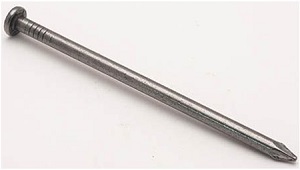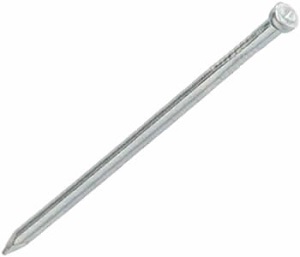Types of nails
Contents |
[edit] Introduction
Nails are a basic type of fastener and have been used in construction in some form for at least 3,000 years. They are most commonly used for joining pieces of timber or for fastening materials to timber and are suitable when a screw is unnecessary.
There are a very wide variety of nails designed for specific purposes and finishes. They are manufactured in different lengths and gauges (diameters), as required.
Nails are usually hammered into place by striking them squarely on their head. By driving the nail in this way, it is less likely to bend or break. When driving a nail into timber, it is good practice to position the nail at a slight angle to the grain of the timber so that it does not split. When timber is likely to split, or a nail is required close to an edge, it may be necessary to drill a ‘pilot hole’ which is slightly smaller than the nail diameter.
Nails must be of suitable strength, with a shank that is long enough to provide an appropriate attachment. Nails are held in place by friction, and some designs can include roughened, grooved or twisted shanks to improve the hold.
Nails are most commonly made of steel. Steel wire is fed into a machine which cuts out individual nail lengths. Wire pieces are held by grippers while a hammer flattens one projecting end to form the head. It is then cut to the specific length and point. Masonry nails are made of hardened zinc for added strength, and many nails (particularly roofing nails) are galvanized with an outer layer of zinc to prevent rusting.
When purchasing nails, it is important to note that suppliers normally sell them by weight rather than quantity. This means that a rough estimate of how many are required is sufficient and over-buying is generally recommended.
[edit] Types
While nails may vary between manufacturers, the most common types include:
[edit] Common nails
Also known as round head, these are the most widely-used type of nail for joining timber and other elements, particularly where a rougher finish is acceptable. It is good practice to use nails that are at least three times longer than the depth of the thinner material that is being nailed.
A variation is the oval head nail which is oval in cross-section and minimises the risk of splitting the timber.
[edit] Finishing nails
These are similar to common nails but have much smaller heads which sit flush with the timber surface and provide a neater finish. A nail set can be used to recess the head to conceal it completely. This capability means that they are often used in furniture and decorative or exposed timber. The smaller head sizes also mean there is a reduced risk of the timber splitting. Finishing nails can be made of brass to provide a decorative detail.
[edit] Box nails
Box nails are commonly used for light construction as they are slightly thinner than common nails and have less strength.
[edit] Roofing nails
These have larger heads and are often used for nailing shingles, attaching asphalt and other roofing purposes. The thin material is held in place and prevented from tearing loose by the large head. Smaller varieties can be used to attach roofing felt. They are typically galvanized to prevent rust.
[edit] Masonry nails
These are harder and thicker nails with small heads, typically made of hardened zinc which is stronger, enabling them to be driven into masonry surfaces effectively. They are often used to attach timber to stone or brick.
[edit] Double-headed nails
These nails are often used to secure scaffolding and other temporary structures in place. They have two heads, one above the other. They are driven in as far as the first head, while the top head remains above the surface, making it easy to remove.
[edit] Drywall nails
Drywall nails are used to hang drywall and are designed not to cut the paper face.
[edit] Annular ring shank nails
These are similar to common nails but comprise rings along the length of the shank. This provides better grip in the timber and a more secure attachment.
[edit] Special
Special types of nails include:
- Casing: For use on small mouldings or thin plywood.
- Brads: Very narrow nails that provide a neat finish. Typically used in nail guns for fast fixing.
- Glazing sprig: A wedge-shaped nail that can be used with putty to secure glazing.
- Cap nail: Includes a plastic cap and is commonly used for nailing building fabrics.
- Upholstery nail: Small, dome-headed nails that are used for attaching upholstery to furnishings.
- Carpet nail: Also known as carpet tacks, they are used to hold down carpet in awkward areas such as corners and stairs.
- Corrugated nail: Has a corrugated cross-section, often used as an 'invisible' connector.
- Staple nail: Has an arched shape for holding wire in position on structures such as fence posts.
[edit] Related articles on Designing Buildings Wiki
Featured articles and news
From studies, to books to a new project, with founder Emma Walshaw.
Types of drawings for building design
Still one of the most popular articles the A-Z of drawings.
Who, or What Does the Building Safety Act Apply To?
From compliance to competence in brief.
The remarkable story of a Highland architect.
Commissioning Responsibilities Framework BG 88/2025
BSRIA guidance on establishing clear roles and responsibilities for commissioning tasks.
An architectural movement to love or hate.
Don’t take British stone for granted
It won’t survive on supplying the heritage sector alone.
The Constructing Excellence Value Toolkit
Driving value-based decision making in construction.
Meet CIOB event in Northern Ireland
Inspiring the next generation of construction talent.
Reasons for using MVHR systems
6 reasons for a whole-house approach to ventilation.
Supplementary Planning Documents, a reminder
As used by the City of London to introduce a Retrofit first policy.
The what, how, why and when of deposit return schemes
Circular economy steps for plastic bottles and cans in England and Northern Ireland draws.
Join forces and share Building Safety knowledge in 2025
Why and how to contribute to the Building Safety Wiki.
Reporting on Payment Practices and Performance Regs
Approved amendment coming into effect 1 March 2025.
A new CIOB TIS on discharging CDM 2015 duties
Practical steps that can be undertaken in the Management of Contractors to discharge the relevant CDM 2015 duties.
Planning for homes by transport hubs
Next steps for infrastructure following the updated NPPF.






























